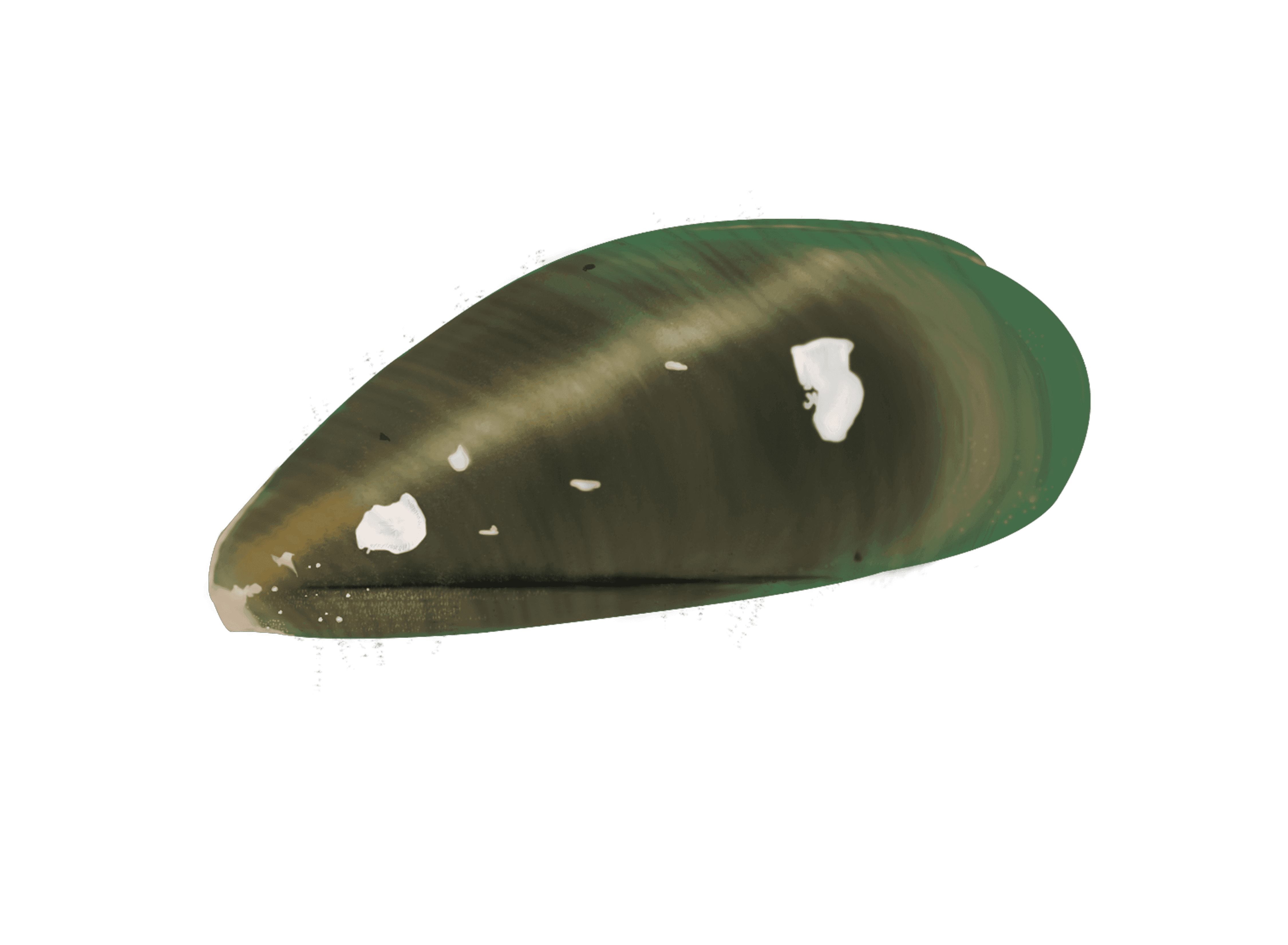New Zealand Green Lip Mussel

Species Details
Perna canaliculus
Mytilidae
Mytilida
Marine coastal
0 - 1 lbs.
3" - 4"
What are these mussels known for?
The New Zealand Green-Lipped Mussel is a saltwater shellfish native to New Zealand's coastal waters, known for its distinctive green-edged shell. Renowned for both its culinary appeal and health benefits, it’s a rich source of omega-3 fatty acids and anti-inflammatory compounds.
New Zealand Green-Lipped Mussel: Nature’s Nutrient-Packed Shellfish
The New Zealand Green-Lipped Mussel (Perna canaliculus) is a unique and iconic bivalve found only in the pristine marine environments of New Zealand. Known for its vibrant green shell edges and exceptional nutritional value, this mussel has become a culinary delicacy and a sought-after supplement worldwide. But beyond its uses, the green-lipped mussel plays a vital role in ocean ecosystems and New Zealand’s aquaculture industry.
Where to Find Green-Lipped Mussels
Green-lipped mussels are endemic to New Zealand, meaning they are naturally found only in this region. They inhabit intertidal and subtidal zones along the coasts and are particularly abundant in areas with strong tidal flow and good water quality. Popular farming regions include:
Marlborough Sounds
Coromandel Peninsula
Stewart Island
Tasman Bay
These mussels are typically grown on longlines in coastal waters, suspended in mesh socks where they feed and grow naturally from the nutrients in the ocean.
Habitat and Environment
Green-lipped mussels thrive in saltwater environments with high water quality. They prefer temperate coastal areaswith a stable food supply of phytoplankton. As filter feeders, they clean the water as they eat, making them beneficial to marine ecosystems.
They attach to submerged surfaces like rocks, ropes, and pilings using strong, thread-like structures called byssal threads. Farms mimic this environment by providing floating structures that support healthy growth and easy harvesting.
Life Cycle of the Green-Lipped Mussel
The life cycle of the green-lipped mussel includes several key stages:
Spawning: Adults release eggs and sperm into the water. This usually occurs in late summer to early autumn.
Larval Stage: The fertilized larvae are free-swimming for about 3 weeks, feeding on microscopic plankton.
Settlement: The larvae settle onto hard surfaces and begin forming shells.
Juvenile (Spat) Stage: Known as spat, the young mussels are collected and transferred to farms where they continue to grow.
Adult Stage: They reach harvest size in 12–18 months, typically about 90–100 mm in length.
Ecological Role
Green-lipped mussels are ecosystem engineers that provide multiple environmental benefits:
Water filtration: One mussel can filter several liters of water per day, removing excess nutrients and particulate matter.
Habitat creation: Mussel beds offer shelter and breeding grounds for various marine species.
Nutrient cycling: Their filter feeding contributes to nutrient distribution in coastal ecosystems.
Sustainable mussel farming practices ensure minimal environmental impact while enhancing local biodiversity.
Regulations and Sustainability
New Zealand has some of the strictest aquaculture regulations in the world. Green-lipped mussel farming is carefully managed by:
MPI (Ministry for Primary Industries)
Aquaculture New Zealand
Regional Councils
Farms must meet high standards for environmental management, water quality, and animal welfare. Additionally, the Aquaculture Stewardship Council (ASC) certifies some farms for responsible practices.
Harvesting wild mussels is also regulated to protect wild stocks. Recreational harvesting limits vary by region, but typically include:
Daily bag limits
Size restrictions
Prohibited zones (marine reserves)
Always check local regulations before harvesting.
Quality for Eating
Green-lipped mussels are highly prized for their taste, texture, and nutritional profile. They have a firm, slightly chewy flesh and a mild, oceanic flavor. When fresh, their meat is green, orange, or cream-colored, and their shells have distinctive emerald edges.
Nutritionally, they are rich in:
Omega-3 fatty acids (EPA and DHA)
Protein
Iron, zinc, and selenium
Chondroitin sulfate and glucosamine (joint support)
They are often processed into freeze-dried or oil-based supplements, used to support joint health in humans and pets.
Culinary Uses
Green-lipped mussels are a versatile seafood item that can be:
Steamed or boiled: A simple preparation that brings out their natural flavor.
Baked or grilled: Often served with garlic butter, breadcrumbs, or cheese.
Added to soups and chowders: Great in seafood broths and curries.
Smoked or marinated: A specialty in New Zealand delicatessens.
Frozen or half-shelled: For convenience in international markets.
They pair well with white wines, citrus, herbs, and cream-based sauces. New Zealand chefs often highlight them in regional cuisine alongside other local seafood.
Conclusion
The New Zealand Green-Lipped Mussel is more than just a shellfish—it’s a symbol of sustainability, a superfood, and a cornerstone of marine biodiversity. Whether you enjoy them on your plate, in your supplement, or in their natural habitat, these mussels offer a powerful example of how aquaculture and nature can coexist.







